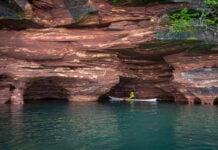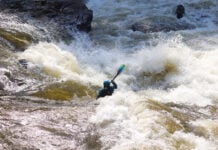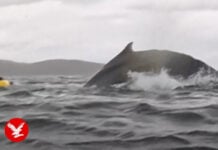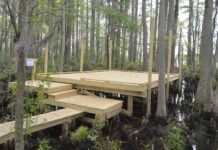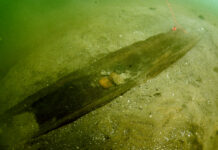Get ready,” I tell the girls. It’s 7:29 a.m. My eyes are fixed on the official boat, where a flag will signal the race start any second, sending us on an 18-mile trek down the Kona coast. Birds fly overhead, probably curious about the 128 forty-foot-long canoes lined up like colorful matchsticks on the brilliant, aquamarine sea. The clock changes to 7:30, but the personal watercrafts in front of us continue to zip back and forth, drawing a whitewater boundary with their wake.
My crew of six has three first-timers, and I can sense their nervousness as we wait. “This is the hardest part,” I call out, only half-kidding.
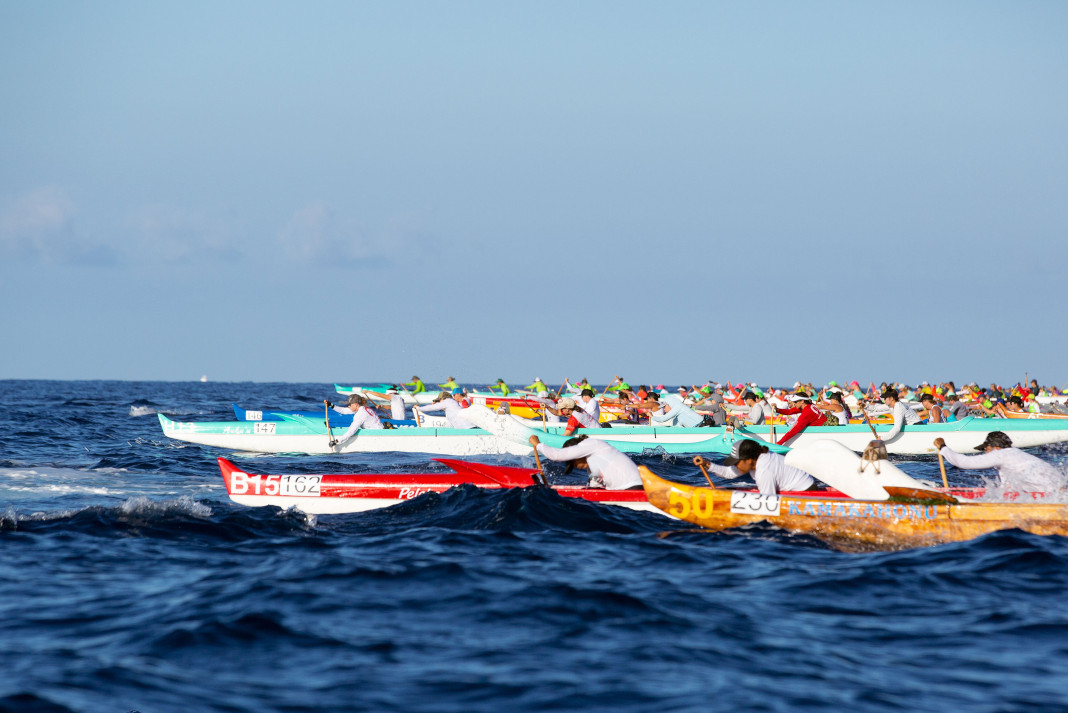
The excitement started building long ago, group texts fluttering as we booked flights and organized practice on O‘ahu’s north shore, home to our canoe club Manu O Ke Kai. We arrived the day before to 1,500 paddlers rigging their canoes on the grounds of the King Kamehameha Hotel. At sunrise, we became part of the mix of teams in matching jerseys duct-taping water systems and power gels to their canoes, tying on bailers and spare paddles, and posing for pre-race selfies.
Muscle and endurance being equal, the crew that can paddle together most efficiently in the Queen Lili‘uokalani Canoe Race—the world’s largest long-distance outrigger canoe race—will prevail.
Lining Up At The Start of the Queen Lili‘uokalani Outrigger Canoe Race
We’re floating right beside Outrigger Canoe Club’s indomitable first crew. “Good luck, ladies!” I holler, and they echo our goodwill. Their energy, our energy, and the energy from the women in all 128 canoes is about to collide with the primal energy of Hawai‘i Island, where the volcanoes Kilauea and Kama‘ehuakanaloa are actively producing new earth above ground and undersea.
The yellow flag goes up, and then the green. The air horn blasts, and the race is on. The paddles hit the water simultaneously on alternating sides. The boats sprint forward.
Individual Tasks For A Common Goal
As the steerswoman in seat six, my job is part navigator, part cheerleader. Whether you’re paddling a traditional koa canoe, a fiberglass “spec” boat, or an ultra-light (a little over 200 pounds) “unlimited” canoe, each person has a job.
Every twelve or so strokes, Michele Sales in seat two calls, “Hut!” That’s the cue to switch the paddle to the other side. After a few minutes, we hit our stride. Some boats—including Outrigger—pull ahead as we battle with a red-and-yellow canoe from Kihei, Maui.
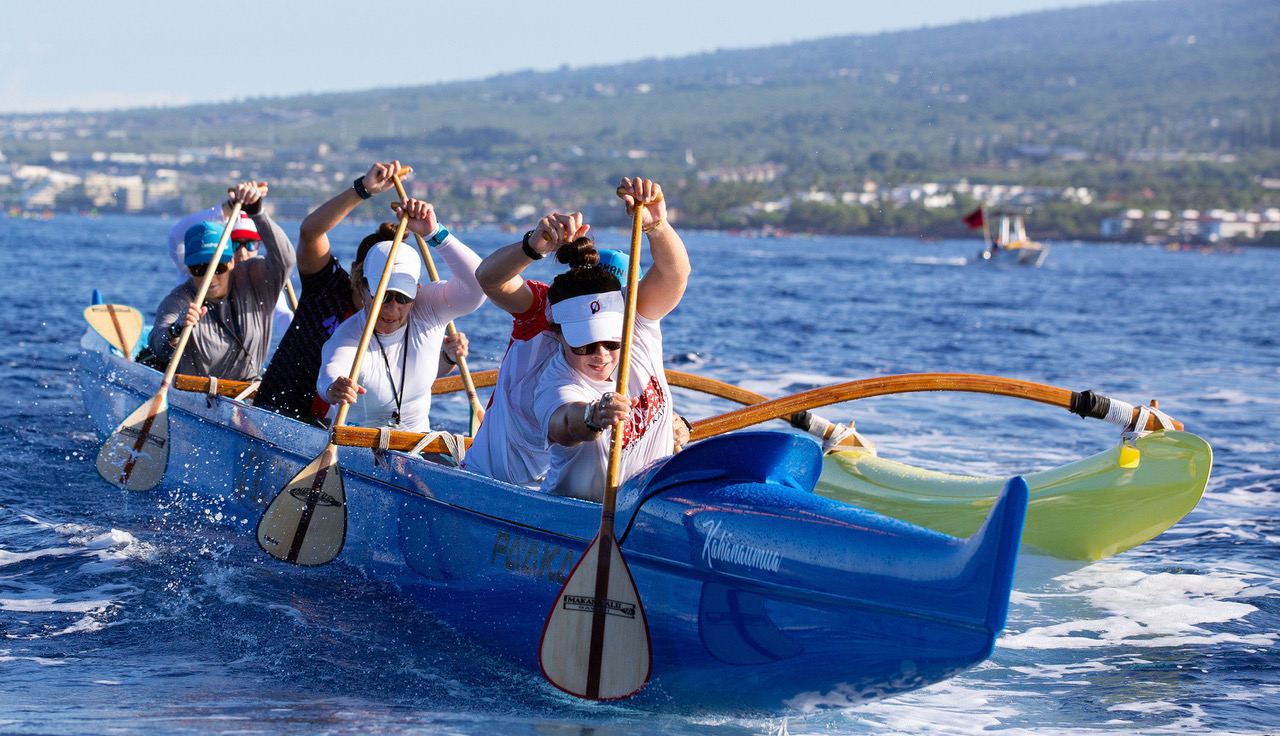
“While we paddled, I focused on keeping a consistent cadence of stroke and feeling how the canoe reacted,” our stroker and pace-setter Jennifer Ignacio shares. “I thought about how far we’d gone and how much more was in front of us.”
“Timing. Timing. Technique.” These mantras were fused in the mind of Bree Thuston, our seat four. Seats three and four are known as the “pit,” the canoe’s engine. Jackie Reiser, a powerhouse in seat three, adds, “I thought about so much but also nothing. It was almost meditative. When my mind wandered, I’d bring it back to the present.”
“Hut!” yells Michele, a veteran whose consistency in matching the stroker is invaluable. She concentrates on taking advantage of every little swell in this typically hot, flat race, timing her “huts” after bursts of acceleration so we don’t disturb the glide. We paddle, we hydrate, we paddle. Inevitably, the going starts to get tough.
Honoring Hawai‘i And Queen Lili‘uokalani
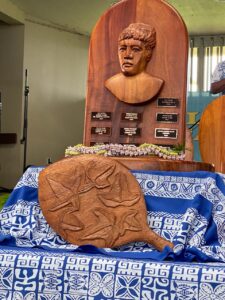
We pass many significant cultural sites on our journey to Hōnaunau. Kona was once the center of the Hawaiian kingdom, and this race honors Queen Lili‘uokalani, Hawai‘i’s last reigning monarch. The race centers around her birthday, September 2. As we approach Kuamo‘o, the battleground where the defenders of the Hawaiian religion fell, I suggest, “None of us are here without someone else’s sacrifice. Paddle for someone you love.”
“Hut!” calls Michele. I feel the canoe lift. The miles start to merge, like hours on a road trip. I marvel at the diversity of crews, hailing from the U.S. mainland, Tahiti, Australia, New Zealand, Canada, and Great Britain.
As we round Kealakekua Bay, where Captain Cook met his fateful end, I spot the volcanic outcropping where we’ll turn into the finish. “This is it,” I tell the crew.
“On cue, we dug into whatever we had left in our tanks, and our boat took off. We walked past the boat we’d been gunning for,” says Molly O’Keefe in seat five, who can help steer the canoe in rough water. “It was incredible to feel the strength we shared.”
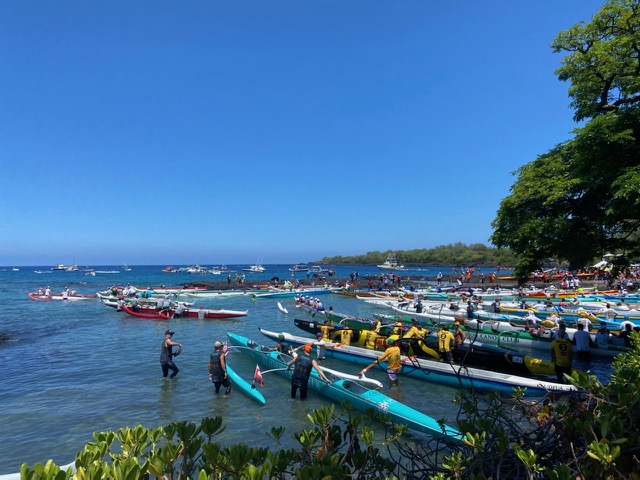
The orange triangle buoy—the finish line—comes into view and our boat soon enters the sacred refuge of Pu‘uhonua o Hōnaunau. Our 18-mile competitive voyage honoring Queen Lili’uokalani is complete with a ninth-place finish in 2 hours, 39 minutes, and 3 seconds.
We maneuver to the lava rock shoreline and carefully climb out of our canoe, another challenging task on this Hawai‘i coastline. “I managed to not step on wana (spiny sea urchins), and somehow find my family in the crowd,” said Bree. Her daughter congratulated each of us with an orchid lei.
“The coastline is still wide open and in this natural state,” race director Mike Atwood said, describing Pu‘uhonua o Hōnaunau. “From the shore looking out, and from the ocean looking in, you can visualize what canoes were doing a hundred years ago. It’s still being perpetuated. It’s being carried on.”
After two years of pandemic pause, the race committee was thrilled to bring everyone back—and is already preparing for next year, the 50th annual Queen Lili’uokalani Race in 2023. None of us say it out loud, but we already know we will be there.
Learn more about the Queen Liliuokalani Race.



